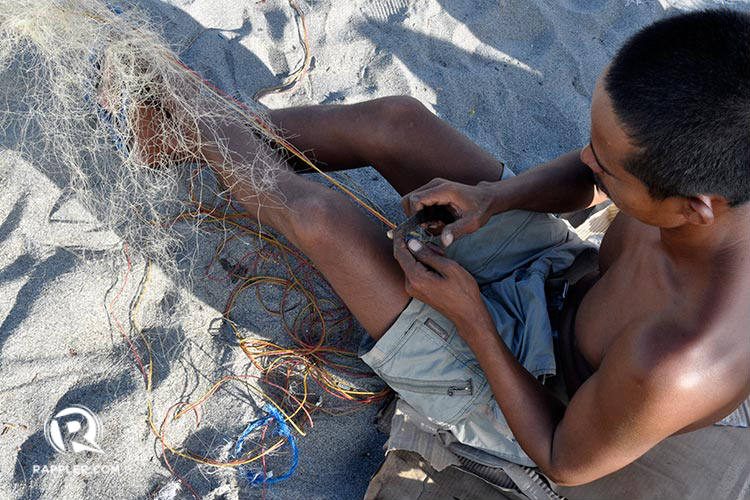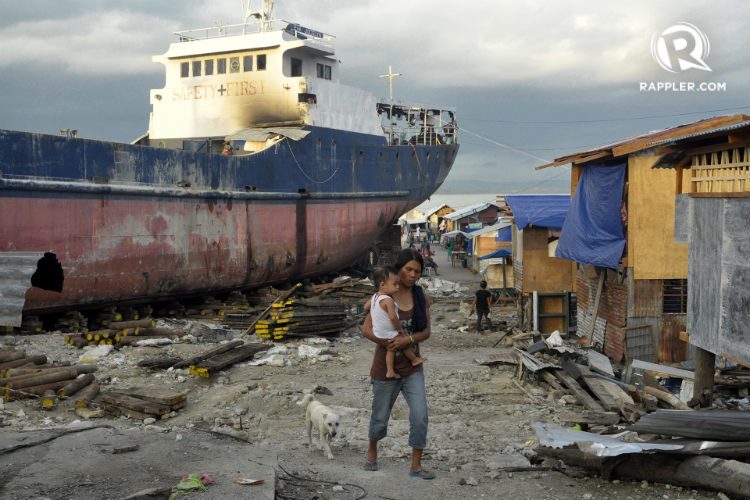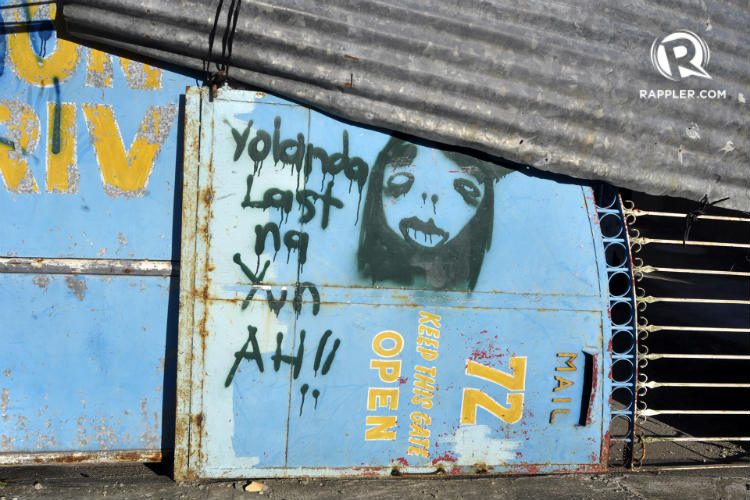SUMMARY
This is AI generated summarization, which may have errors. For context, always refer to the full article.

LEYTE, Philippines – Raymond Gabriel sits by the sandy shores of Barangay San Jose in Tanauan, salvaging what he can from a ruined fishing net.
It has been a long day. Then again, most days are long for the 27-year-old fisherman. He goes to sea at 3 am and is back on dry land by roughly 12, taking home P250-P300. If he’s lucky, he brings home P500.
It’s less than he usually earned before Typhoon Yolanda (Haiyan) hit Tanauan on November 8, 2013. Fishing isn’t as lucrative as it used to be, he says.
More people from the coastal community started fishing after groups offered bangkas for free or through loans. “Marami kayong nag-aagawan,” he said. (A lot of people are going after the same thing.)
Raymond can’t blame his neighbors and other fishermen in the area. Life after Yolanda is an upward climb – while government struggles to kickstart its rehabilitation programs and non-governmental organizations fill gaps left by government, communities piece together their lives and livelihoods, aware that aid won’t last forever.
The climb is a little steeper, however, for people like Raymond. San Jose, a coastal community composed mostly of fisherfolk, is a “no build” or “no dwelling” zone. Yolanda survivors can return to where their houses used to be, but are not allowed to build permanent structures.
When before it was fear that gripped towns like Tanauan, now it is uncertainty – the local government promises temporary and permanent relocation for those displaced by Yolanda. But it will take a long time before those promises are fulfilled – up to 3 years for permanent shelter, local chief executives, and aid workers estimate.
The ideal deadline for completing the relocation sites? “[It should have been] yesterday,” Tacloban city Mayor Alfred Romualdez told Rappler in an interview.
Plans made, deadlines not met
Jocelyn Namita lives, used to live in, or temporarily lives in Barangay Anibong in Tacloban city, the province and region’s commercial hub. Jocelyn isn’t sure which tense to use, even as she oversees the construction of a makeshift home for her family of 3.
There’s a huge ship that towers right across her “new” coastal home, with the words “SAFETY FIRST” emblazoned on its hull. Children play under and around the ship, oblivious to the oddity of its presence or that the bones of Yolanda victims are still trapped under it.

This is what a decent or “good enough” response looks like. At the 6-month mark, the assessment of Yolanda response – by local and national government, and by local and international aid groups – has been mixed.
Regional center Tacloban, according to Romualdez, needs between 30 to 40 more hectares of land to build temporary and permanent relocation sites. Guiuan, where Yolanda first made landfall, needs between 7 to 8 more hectares of land, according to town mayor Christopher Sheen Gonzales.
United Nations Refugee Agency (UNCHR) Country Representative Bernard Kerblat said the difficulties of Romualdez, Gonzales, and many other local chief executives is not surprising.
“Finding land, going through the legal measures for these local government units to acquire this land takes time… It takes time to build transitional shelter and permanent housing. Given the magnitude of it, I understand,” Kerblat told Rappler.
This, despite activating the “entire state apparatus” in motion.
Several bottlenecks in the rehabilitation process have since been pinpointed by local and national government officials alike. Rehabilitation czar Panfilo Lacson mentions two Cabinet secretaries who are making coordination efforts difficult, Romualdez says as much, telling Rappler disagreements in national government make it harder for local officials to plan and react adequately.
But the problem, said OxFam Humanitarian Crisis expert Tariq Riebl, boils down to money not reaching local government units (LGUs). In the end, it’s those who survived Yolanda’s wrath who suffer.
“If I were a survivor, with responsibility for my family, my children and my wife, my siblings and… yes, I would also be impatient because it takes time,” added Kerblat.
Lives, land, livelihood
The only “bright spot” in the areas devastated by Yolanda is Tanauan, less than an hour’s drive away from Tacloban. By the 6-month mark, Tanauan mayor Pel Tecson said he’s secured all the land that he needs to relocate more than 1,000 families. By November 8, 2014, – a year after Yolanda hit the Eastern Visayas region, all permanent housing in Tanauan is scheduled to be finished.
But even with land secured, the condition of “homeless” survivors in Tanauan is less than ideal. (READ: Immunity from rehab delays? Tanauan stands out)
In many poor, rural areas, dwellings are tied closely to livelihood. When Yolanda swept the coastal barangays of Leyte and Eastern Samar, bancas were broken into pieces and lambats (nets), blown away into oblivion. It makes recovery even harder.
Jove Ronquillo is still surprised her family of 7 survived Yolanda, braving strong winds and the piercing cold for over 5 hours in another town. Their return to the poblacion of Guiuan was an even bigger surprise.
After they got word that food was already available in the sleepy Eastern Samar town, Jovy and her husband Arnel returned to their hometown, only to find that their home had been reduced to stilts protruding from the now-calm ocean water.

Still, one by one, Jove and her brothers and sister returned to Guiuan and now share a makeshift home where 5 families now live. Their house is made of scrap coconut wood and any other scraps they could find. Scraps from her father’s and husband’s banca, she said, now serve as their “kitchen” floor.
None of the materials they used to reconstruct their home came from the government or an aid group. All 5 families chipped in, with a little financial push from relatives who weren’t affected by Yolanda.
“The Filipino is very resilient, they’re taking matters into their own hands… they’re rebuilding. And if aid comes along their way, they welcome it,” Kerblat said.
Resilience is working for the Ronquillo family so far, but it won’t stand another typhoon, or even a low pressure area (LPA). “Misking LPA (low pressure area), basa na rayon mi diri,” Jove said. (When a low pressure area comes, we’re drenched again.)
Desperate measures
Humanitarian crisis experts say storms aren’t the only dangers survivors face. With livelihoods in danger, it won’t take much to push poor communities into deeper debt.
Crisanta Villaro, a market vendor in Tanauan, resorts to borrowing money from informal lenders who typically have a 20% interest rate. Although the local government offers loans through public banks, Crisanta said she didn’t opt for it because the paperwork would take too long, and would eat up time she could have spent selling vegetables in the public market.
Recently widowed and with a nephew to support through college, there is no semblance of savings for the 57-year-old. “Borrowing money and paying back with high interest rates… that’s going to push a lot of the more vulnerable segments of the population into poverty,” said Kerblat.
There’s also the possibility of human trafficking. These issues, said Riebl, typically rear their ugly heads once relief – in the form of food, cash-for-work programs, and dole-outs – end.

“This was a problem before the typhoon, again because of the poverty of the people… as relief stops or slows down, there are worries about negative coping mechanisms. We expect trafficking to go up,” said Riebl.
“Whatever gain that’s been reached before Yolanda… I’m afraid Yolanda, with its surge, has pushed back. That also requires additional resources, in order to regain what was done in the past,” added Riebl.
The problem of housing isn’t just about whether home is a temporary barong-barong or a newly-constructed concrete house. While government officials point fingers, squabble over budgets, and hold press conferences to reveal lists, survivors are in danger of falling victim to another tragedy. – Rappler.com
Add a comment
How does this make you feel?
There are no comments yet. Add your comment to start the conversation.